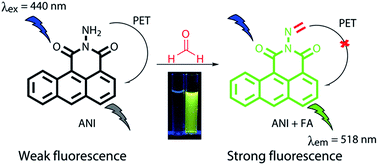A fluorescence-enhanced probe for rapid detection of formaldehyde and its application for cell imaging†
Abstract
A simple anthracene carboxyimide-based fluorescent probe has been readily developed for the detection of toxic formaldehyde (FA). The probe displays a remarkable fluorescence turn-on response towards FA based on the aldimine condensation reaction, which was confirmed by the HR-MS spectrum. The probe can quantitatively determine the level of FA with high selectivity and fast response (within 3 min). Furthermore, cell staining experiments indicate that the probe was cell membrane permeable and could be used for imaging FA in living cells with good performance. Therefore, this probe has promising applications for the detection of FA in living cells.



 Please wait while we load your content...
Please wait while we load your content...